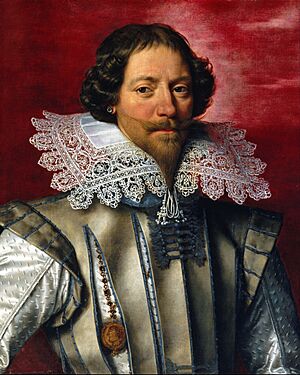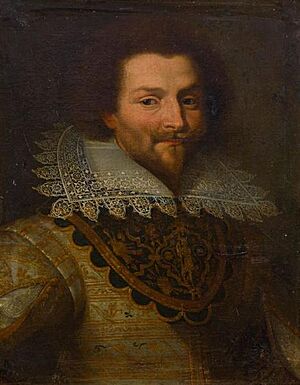Charles d'Albert, 1st Duke of Luynes facts for kids
Quick facts for kids
Charles d'Albert
1st Duke of Luynes
|
|
|---|---|

Portrait of the 1st Duke of Luynes, by Frans Pourbus the Younger
|
|
| Grand Constable of France | |
| In office 31 March 1621 – 15 December 1621 |
|
| Monarch | Louis XIII |
| Preceded by | Henri I de Montmorency |
| Succeeded by | François de Bonne, duc de Lesdiguières |
| Personal details | |
| Born | 5 August 1578 |
| Died | 15 December 1621 (aged 43) Château de Longueville, Guienne |
| Cause of death | Scarlet fever |
| Spouse |
Marie de Rohan
(m. 1617) |
| Relations | Honoré d'Albert (brother) Antoinette d'Albert de Luynes (sister) Charles Honoré d'Albert, duc de Luynes (grandson) Jeanne Baptiste d'Albert de Luynes (granddaughter) |
| Children | Louis Charles, Duke of Luynes |
| Parents |
|
Charles d'Albert, 1st Duke of Luynes (born August 5, 1578 – died December 15, 1621) was an important person in the French royal court. He was a close friend and trusted advisor to King Louis XIII. In 1619, the king made him a Duke of Luynes and a Peer of France. This meant he was one of the most important nobles in the country. In 1621, he became the Constable of France, which was the highest military position. Charles d'Albert died from scarlet fever at the end of 1621, when he was at the peak of his power.
Contents
Who Was Charles d'Albert?
Charles d'Albert was the oldest son of Anne de Rodulf and Honoré d'Albert. His father was a seigneur (a lord) from Luynes in Provence, France. His father worked for several French kings, including Henry IV of France.
Charles had a brother named Honoré. Honoré later became the 1st Duke of Chaulnes and a Marshal of France. He was a military leader who successfully defended his region in battles. Charles also had a sister, Antoinette d'Albert de Luynes, who was a lady-in-waiting to the queen.
Charles grew up at the royal court. He became a close companion to the dauphin, who later became King Louis XIII. The king and Charles shared a love for hunting. This friendship helped Charles gain favor and rise quickly in importance at court.
How Did He Rise to Power?
Charles d'Albert quickly gained important roles. In 1615, he was put in charge of the Louvre Palace and became a royal advisor. The next year, he became the Grand Falconer of France, a high position in the king's household.
He used his strong influence over King Louis XIII to get involved in court politics. At the time, the king's mother, Marie de' Medici, and her favorite advisor, Concini, had a lot of power. Charles d'Albert helped plan a secret plot that led to Concini's death in 1617. After this, Charles gained many of Concini's properties in France and Italy.
In 1617, Charles was also made captain of the Bastille prison and a military leader in Normandy. He took strong actions against people who wrote critical pamphlets (small books) about the government. However, he also tried to create peace in Italy and with the Protestants in France.
Becoming a Duke
In August 1619, Charles d'Albert helped negotiate the Treaty of Angoulême. This agreement gave the queen mother, Marie de' Medici, complete freedom. In the same month, he was made governor of Picardy and given the title of Duke of Luynes.
He had recently bought a large area of land called the Comté de Maillé. This land was near Tours and included about 50 villages. The king then made Maillé into the Duchy of Luynes. On November 14, 1619, Charles was officially recognized as a duke and a Peer of France in a special ceremony.
His quick rise to power made many people jealous and created enemies. They saw him as another powerful favorite, like Concini. In 1620, he helped put down an uprising by some nobles who were unhappy with his influence.
Leading a Military Campaign
In 1621, King Louis XIII asked Charles d'Albert to lead a military campaign against the Protestants in southwestern France. Charles had been against this campaign for a long time. However, as part of the agreement, the king made him Constable of France. This was the highest military rank, even though Charles did not have much military experience. He officially took the role on April 2.
Charles received this important job partly because the other obvious choice, the Duke of Lesdiguières, was a Protestant and refused to change his religion. (Later, after Charles's death, Lesdiguières did convert and became constable.)
Charles d'Albert was involved in the Siege of Montauban (August 17 – November 2, 1621), which was not successful. He received a lot of criticism for this, even though he was not the main commander in the field.
Personal Life and Family
In 1617, Charles d'Albert married Marie Aimée de Rohan. She was 22 years younger than him. Together, they had a son:
- Louis Charles d'Albert de Luynes (1620–1690), who became the 2nd Duke of Luynes. He married three times and had children.
Charles d'Albert died of scarlet fever on December 15, 1621, when he was 43 years old. He died at Château de Longueville in Guienne.
After his death, his wife Marie remarried to Claude de Lorraine, Duke of Chevreuse. They had three daughters. When Claude died, Marie inherited the Duchy of Chevreuse. After Marie's death in 1679, her son Louis-Charles (from her marriage to Charles d'Albert) inherited the Duchy of Chevreuse. His family has held this title ever since.
His Grandchildren
Through his son Louis, Charles d'Albert became a grandfather to six children. Two of his notable grandchildren were:
- Charles Honoré d'Albert, duc de Luynes (1646–1712)
- Jeanne Baptiste d'Albert de Luynes (1670–1736), who is famous for being the mistress of King Victor Amadeus II of Sardinia.
Images for kids
See also
 In Spanish: Charles de Luynes para niños
In Spanish: Charles de Luynes para niños



